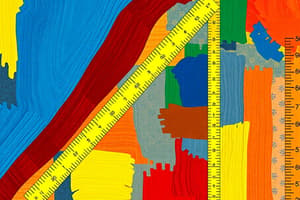Podcast
Questions and Answers
A car travels the first third of a journey at a speed of 30 m/s, the second third at 40 m/s, and the last third at 50 m/s. What is the average speed of the car for the entire journey?
A car travels the first third of a journey at a speed of 30 m/s, the second third at 40 m/s, and the last third at 50 m/s. What is the average speed of the car for the entire journey?
- 41.2 m/s
- 38.3 m/s (correct)
- 39.1 m/s
- 40 m/s
A particle's velocity is described by the function $V(x) = 3x^2 + 2x$. What is the particle's acceleration at $x = 2$?
A particle's velocity is described by the function $V(x) = 3x^2 + 2x$. What is the particle's acceleration at $x = 2$?
- 40 m/s^2
- 28 m/s^2
- 30 m/s^2
- 26 m/s^2 (correct)
A ball is launched vertically upwards with an initial speed of 20 m/s. Neglecting air resistance, what is the maximum height reached by the ball? (Assume $g = 9.8 m/s^2$)
A ball is launched vertically upwards with an initial speed of 20 m/s. Neglecting air resistance, what is the maximum height reached by the ball? (Assume $g = 9.8 m/s^2$)
- 20.41 m (correct)
- 40.82 m
- 25.51 m
- 30.61 m
A projectile is launched with an initial velocity $U$ at an angle $\theta$ with respect to the horizontal. If the maximum height reached by the projectile is equal to its range, what is the value of $\theta$?
A projectile is launched with an initial velocity $U$ at an angle $\theta$ with respect to the horizontal. If the maximum height reached by the projectile is equal to its range, what is the value of $\theta$?
Two cars, A and B, are moving in the same direction. Car A has a velocity of 25 m/s and Car B has a velocity of 15 m/s. What is the magnitude of the relative velocity of Car A with respect to Car B?
Two cars, A and B, are moving in the same direction. Car A has a velocity of 25 m/s and Car B has a velocity of 15 m/s. What is the magnitude of the relative velocity of Car A with respect to Car B?
In dimensional analysis, which of the following functions must have dimensionless arguments?
In dimensional analysis, which of the following functions must have dimensionless arguments?
A student measures a length four times and obtains the following values: 10.2 cm, 10.1 cm, 9.9 cm, and 10.0 cm. What is the correct way to express the final measurement, including absolute error?
A student measures a length four times and obtains the following values: 10.2 cm, 10.1 cm, 9.9 cm, and 10.0 cm. What is the correct way to express the final measurement, including absolute error?
If a quantity x is calculated as $x = (a^2 * b) / c$, and the percentage errors in a, b, and c are 2%, 3%, and 4% respectively, what is the percentage error in x?
If a quantity x is calculated as $x = (a^2 * b) / c$, and the percentage errors in a, b, and c are 2%, 3%, and 4% respectively, what is the percentage error in x?
A vernier caliper has 20 divisions on its vernier scale that coincide with 19 divisions on the main scale. If each main scale division is 1 mm, what is the least count of the caliper?
A vernier caliper has 20 divisions on its vernier scale that coincide with 19 divisions on the main scale. If each main scale division is 1 mm, what is the least count of the caliper?
What is the angle between two vectors $\vec{a}$ and $\vec{b}$ if their magnitudes are equal and the magnitude of their resultant is also equal to the magnitude of either vector?
What is the angle between two vectors $\vec{a}$ and $\vec{b}$ if their magnitudes are equal and the magnitude of their resultant is also equal to the magnitude of either vector?
Two vectors, $\vec{a} = 2\hat{i} - \hat{j} + \hat{k}$ and $\vec{b} = \hat{i} + \hat{j} - 2\hat{k}$, define two sides of a triangle. What is the area of the triangle?
Two vectors, $\vec{a} = 2\hat{i} - \hat{j} + \hat{k}$ and $\vec{b} = \hat{i} + \hat{j} - 2\hat{k}$, define two sides of a triangle. What is the area of the triangle?
A particle moves along a straight line such that the distance traveled is directly proportional to the square of the time. What can be concluded about the velocity of the particle?
A particle moves along a straight line such that the distance traveled is directly proportional to the square of the time. What can be concluded about the velocity of the particle?
A car travels half of its journey with a speed of 40 m/s and the remaining half with a speed of 60 m/s. What is the average speed of the car for the entire journey?
A car travels half of its journey with a speed of 40 m/s and the remaining half with a speed of 60 m/s. What is the average speed of the car for the entire journey?
Flashcards
Dimensionless Arguments
Dimensionless Arguments
Arguments within trigonometric, logarithmic, and exponential functions must be dimensionless.
Average Value
Average Value
Sum of measurements divided by the number of measurements.
Absolute Error
Absolute Error
The absolute difference between a single measurement and the average value.
Mean Absolute Error
Mean Absolute Error
Signup and view all the flashcards
Relative Error
Relative Error
Signup and view all the flashcards
Resultant Vector Magnitude
Resultant Vector Magnitude
Signup and view all the flashcards
Average Velocity
Average Velocity
Signup and view all the flashcards
Average Speed
Average Speed
Signup and view all the flashcards
Average Speed (Equal Lengths)
Average Speed (Equal Lengths)
Signup and view all the flashcards
Displacement in nth Second
Displacement in nth Second
Signup and view all the flashcards
Projectile Motion Velocity
Projectile Motion Velocity
Signup and view all the flashcards
Trajectory Equation
Trajectory Equation
Signup and view all the flashcards
Relative Displacement
Relative Displacement
Signup and view all the flashcards
Study Notes
- Lecture about formulas and concepts for the JEE and NEET physics exams for class 11
- Conceptual understanding and derivation is more important than Rote memorization
- The notes summarize formulas and provide context, not to solve questions
Units, Dimensions, and Errors
- Arguments of trigonometric, logarithmic, and exponential functions must be dimensionless in dimensional analysis
- Average value is the sum of measurements divided by the number of measurements
- Absolute error = |measurement - average value|
- Mean absolute error = average of all absolute errors
- Final measurement = mean ± mean absolute error
- Relative Error (Fractional Error) = Mean Absolute Error / Average value
- Percentage Error = Relative Error * 100
- For x = (a^A * b^B) / (c^C * d^D), the % error in x = A(% error in a) + B(% error in b) + C(% error in c) + D(% error in d)
- If x = a+b, absolute error in x = absolute error in a + absolute error in b
- If x = a-b, absolute error in x = absolute error in a + absolute error in b
- Least count of vernier calipers = smallest division on main scale - smallest division on vernier scale
- Total reading with calipers = main scale reading + vernier scale reading
- Corrected value = Total Reading - Zero Error; instruments showing readings when they should be zero have positive error.
Vectors
- |a + b| = √(a² + b² + 2ab cos θ), where θ is the angle between vectors a and b.
- |a - b| = √(a² + b² - 2ab cos θ)
- When |a| = |b| = x, then |a + b| = 2x cos(θ/2) and |a - b| = 2x sin(θ/2)
- Magnitude of a vector = √(x² + y² + z²)
- Scalar product: a ⋅ b = |a||b| cos θ
- Cross product magnitude: |a × b| = |a||b| sin θ
- Area of triangle with sides a and b: 1/2 * |a × b|
- Area of parallelogram with adjacent sides a and b: |a × b|
- Cross product components involves calculating the determinant of a matrix
Kinematics Part 1
- Average velocity: total displacement / total time
- Average speed: total distance / total time
- For equal time intervals, average speed is the arithmetic mean
- If a body travels equal lengths at different speeds, the average speed formula uses the harmonic mean
- Standard equations of motion: vf = vi + at, s = vi(t) + 0.5at², vf² = vi² + 2as
- General Acceleration Formula: a = dV/dt
- If V= f(x), then a = V(dV/dx)
- Displacement in nth second = u + a/2(2n - 1)
- For vertical launch with speed u, max height h = u² / (2g), time of flight T = 2u / g
Kinematics Part 2
- Projectile motion has a constant x-component of velocity and a changing y-component
- Time of flight = (2 * U * sin(theta)) / g
- Max height = (U^2 * sin^2(theta)) / (2g)
- Trajectory Equation: y = tan(theta) * x - (g * x^2) / (2 * U^2 * cos^2(theta))
- For projectile motion, 4 * hMax / Range = tan(theta)
- For projectile motion on an incline: Time of Flight = (2 * U * sin(alpha)) / (g * cos(theta)), Range = (2 * U^2 * sin(alpha) * cos(theta + alpha)) / (g * cos^2(theta))
Relative Motion
- Relative Displacement = Sa - Sb
- Relative Velocity = Va - Vb
Studying That Suits You
Use AI to generate personalized quizzes and flashcards to suit your learning preferences.




